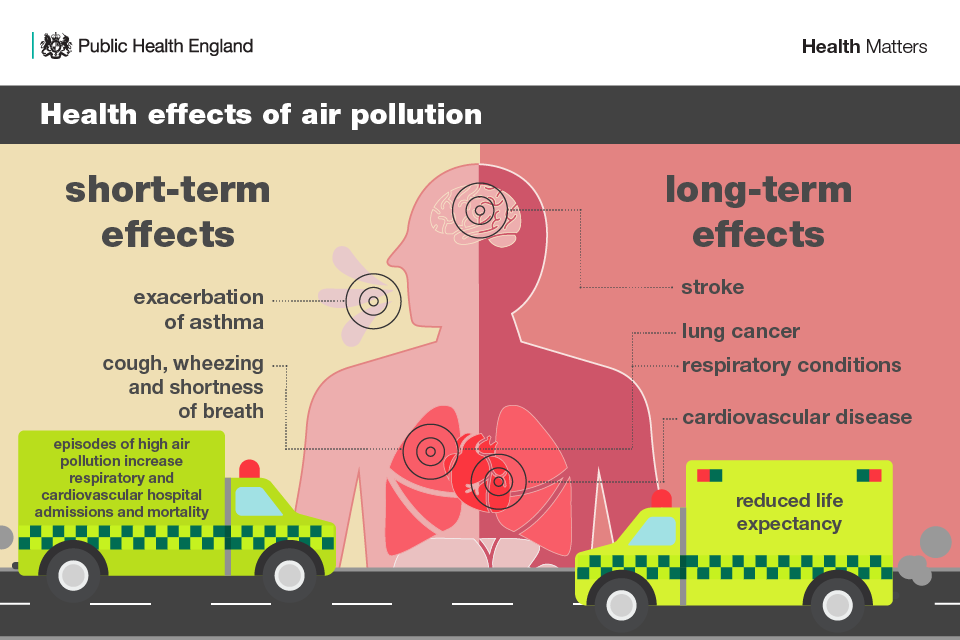
Daily Air Quality Index (DAQI)
The data sites include a Daily Air Quality Index' (AQI) value to help you manage your short term exposure to air pollutants.
The Daily Air Quality Index (DAQI) is a government information system that provides updates on air pollution levels and gives recommended actions and health advice relating to short term air pollution exposure. The index is numbered 1-10 and divided into four bands, low (1) to very high (10), similar to the sun or pollen index.
The index provides two types of health advice. One for the general population and one for those who are most at risk from short term exposure to elevated pollutant concentrations.
You should follow the 3 steps below to use the Daily Air Quality Index.
Step 1: Determine whether you (or your children) are likely to be at-risk from air pollution.
Information on people who may be affected is provided here: Defra advice on short term effects of air pollution on health. Your doctor may also be able to offer you further advice and should be consulted if you experience any symptoms you think could be related to air pollution exposure.
Step 2: If you may be at-risk, and are planning strenuous activity outdoors, check the national air pollution forecast.
Step 3: Use the health messages below corresponding to the highest forecast level of pollution as a guide. Choose the message which best reflects your personal level of risk.
More information about the DAIQ and how to use it is available here: The Daily Air Quality Index (DAQI)
Recommended actions and health advice
| Air pollution banding | Value | Accompanying health messages for at-risk individuals* | Accompanying health messages for general population |
|---|---|---|---|
| Low | 1-3 | Enjoy your usual outdoor activities. | Enjoy your usual outdoor activities. |
| Moderate | 4-6 | Adults and children with lung problems, and adults with heart problems, who experience symptoms, should consider reducing strenuous physical activity, particularly outdoors. | Enjoy your usual outdoor activities. |
| High | 7-9 | Adults and children with lung problems, and adults with heart problems, should reduce strenuous physical exertion, particularly outdoors, and particularly if they experience symptoms. People with asthma may find they need to use their reliever inhaler more often. Older people should also reduce physical exertion. | Anyone experiencing discomfort such as sore eyes, cough or sore throat should consider reducing activity, particularly outdoors. |
| Very High | 10 | Adults and children with lung problems, adults with heart problems, and older people, should avoid strenuous physical activity. People with asthma may find they need to use their reliever inhaler more often. | Reduce physical exertion, particularly outdoors, especially if you experience symptoms such as cough or sore throat. |
*Adults and children with heart or lung problems are at greater risk of symptoms. Follow your doctor's usual advice about exercising and managing your condition. It is possible that very sensitive individuals may experience health effects even on Low air pollution days.
Air pollution forecasts for Bradford for the next 5 days, are available here: Pollution forecast for Bradford. The forecasts are provided to allow you to plan ahead and where relevant, take the recommended action to reduce the effects of short term air pollution exposure.
Short and long term pollutant exposure
You may have noticed that the Pollution forecast for Bradford is low on most days and be wondering why in this situation we still need a Clean Air Zone and Air Quality Management Areas.
Air pollution has both short term ‘acute’ and long term ‘chronic’ impacts on health. It therefore also has short term and long term air quality objectives.
| Pollutant | Short term objective | Long term objective |
|---|---|---|
| Nitrogen dioxide | 1 hour average not to exceed 200μg/m3 more than 18 times per year | Annual average of 40μg/m3 |
| PM10 | 24 hour average not to exceed 50 μg/m3 more than 35 times per year | Annual mean of 40μg/m3 |
The Daily Air Quality Index (DAQI) and pollution forecasts focus on short term ‘acute’ health impacts which are most severe during pollution episodes. During a pollution episode hourly concentrations of pollutants can rapidly increase and occasionally exceed the short term air quality objectives.
Severe pollution episodes are now quite rare in the UK and usually only last a few days. Bradford hasn’t experienced any exceedances of the short term air quality objectives in recent years. For the majority of the general population (those with no existing health conditions) the maximum hourly concentrations of pollutants on a typical day in Bradford are normally in the low category and unlikely to result in acute health impacts. Even during pollutant episodes short term concentrations rarely reach the ‘high’ or ‘very high’ categories in Bradford. This is why the short term pollutant forecast is usually ‘low’ and the map is nearly always green.
Although short term hourly pollutant concentrations are usually low in Bradford the long term ‘chronic’ pollutant objectives are still exceeded in a number of locations around the district.
Chronic health impacts are the result of pollutants entering the body on a regular basis over long periods of time. Even if the daily intake of pollutants is not very high the cumulative impacts over time can have serious consequences resulting in heart disease, lung disease and links to other conditions such as dementia and diabetes. Regular intake of relatively low levels of air pollutants can damage the body over a long period, similar to having a very bad diet or regularly drinking too much alcohol. In the same way as we have recommended levels of intake for things like salt and alcohol the long term objectives for air pollutants are aimed at providing a safer level of pollutant exposure over a lifetime, however for some pollutants such as PM there are still no known safe levels of life time exposure.

In Bradford the long term health objectives for NO2 are still exceeded at some locations hence why we still need to have the CAZ and AQMAs. A new long term standard for PM2.5 has recently been agreed by the government and it is likely that this will also be exceeded in some parts of Bradford as well. Bradford is currently developing a Particle Reduction Strategy (PRS) to address long term particulate levels in the district.